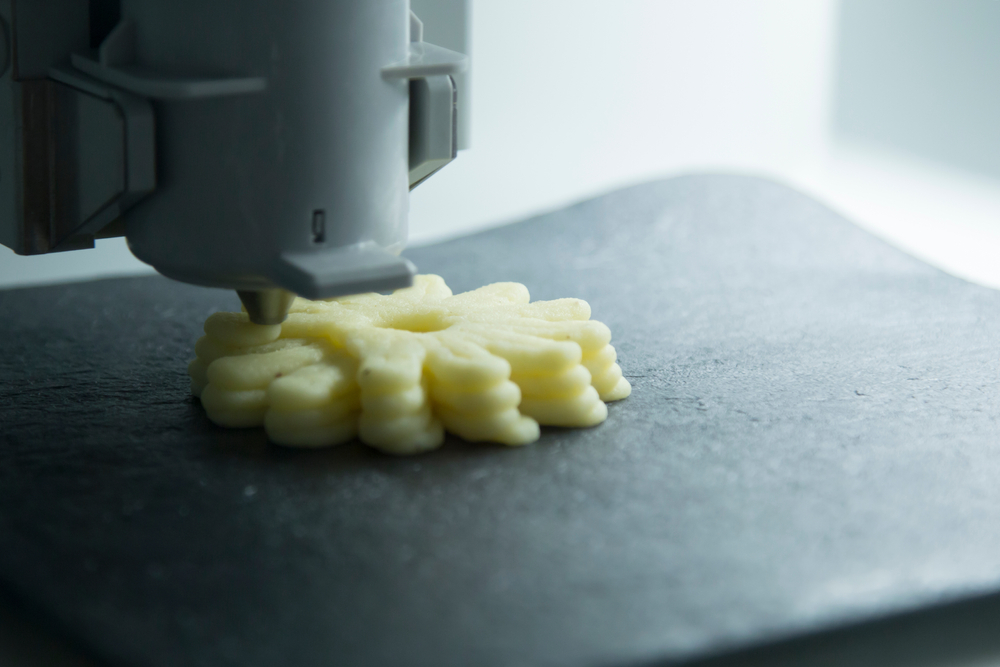Malaysia, among other countries worldwide, is at risk of food security issues in the future. The overreliance on imported food from other countries might create a chain of events that could disrupt the food supply for the locals. Moreover, there is a growing concern about the low quality of food consumed by the population, leading to health issues. Developing food products that cater to consumers’ specific needs must be emphasised to address these challenges. This process often involves incorporating innovative technologies into food processing methods to create innovative and unique products.
Revolution of Utensils
In the kitchen, conventional cooking utensils include a stove, oven, grill, blender, mixer, and pots and pans, which are common in households worldwide. However, the culinary landscape is on the verge of a paradigm shift with the introduction of food 3D printers. The state-of-the-art appliance has emerged as the future of kitchen appliances. It is set to revolutionise the cooking industry and completely redefine the concept of gastronomy, giving conventional cooking tools a new makeover. Imagine a scenario where food products are being made autonomously by utilising precise ingredient ratios to cater to the needs of certain individuals. The slightest aspects, such as taste, nutritional value, and even texture, can be altered according to the customers’ preferences.
3D Printing Concepts
3D printing is a technology that emphasises forming a three-dimensional structure through a layering process, in which materials are layered sequentially on top of one another. It is similar to the LEGO concept of building one block at a time to construct 3D models. This simple concept has created interest in many industries, including aerospace, medicine, dentistry, automotive, robotics, and education. Furthermore, during the pandemic, 3D printing was used to fabricate emergency products such as face-mask, face-shields, ventilator valves, nasopharyngeal swabs, and even metal respiratory filters. Such capabilities open innovation in other fields as well.
3D Printing Scrumptious Delicacies
With that being said, imagine an experience eating edible creation from a machine that fabricates complex structures encompassing an array of edible ingredients with precision and efficiency. Now, the food industry is exploring such 3D printing technology to create new futuristic applications that will open new possibilities for chefs, nutritionists, and food enthusiasts, allowing them to innovate entirely new recipes and change how we experience food. The exquisite dishes can be printed in fancy restaurants and at the convenience of your own home. The potential impact might disrupt the conventional fine dining experience.
Diet/Patient-Specific 3D Printed Nutritious Meals
In modern-day technology, food 3D printing technology has a distinct advantage over its counterpart in its remarkable capabilities to customise and tailor food based on the consumers’ needs, dietary requirements, and personal preferences. This customisation can be achieved through specific ingredients at a certain location in the food structure, resulting in optimal flavour with unique shapes and textures while catering to dietary restrictions by optimising the nutritional contents. These unique capabilities allow the usage of such technology not only for restaurants but also for hospitals so that they can cater for patient-specific meals.
Food Security Issue
Furthermore, with the growing concern of food security having taken the headlines worldwide, food 3D printers can be considered as a possible solution. Food 3D printers allow the effective utilisation of food resources, in which the portion of the food printed is precisely measured and controlled to provide an accurate amount of ingredients to create the meals, ultimately helping reduce overconsumption and minimise waste during cooking. Besides, food 3D printing enables the production to be made locally, lowering the carbon emissions due to transportation. This benefit will improve the local economy and reduce the reliance on imported goods from other countries. Additionally, more ingredients can be utilised to construct new products, which allow different flavours and nutrients to be inserted, especially local fruits such as durian, rambutan, cempedak, and much more.
Multi-Ingredients
Moreover, food 3D printing has progressed significantly in terms of materials utilisation. In the early stages of development, the commonly employed materials or ingredients are chocolate, cookie dough, and cheese. The reason behind choosing these ingredients is primarily driven by the ability of the ingredients to transform the liquid state when melted to a solid state after solidification rather quickly. The more recent examples of futuristic ingredients are cultured meat derived from cultivating animal cells and meat analogues made from plant-based materials such as peas and soybeans. These novel ingredients create a new phase of sustainable food production with long-term global implications and address environmental challenges, particularly carbon emissions. Here, the utilisation of local ingredients will play a significant role. Using home-grown vegetables to create our meat analogues is particularly advantageous in producing unique and delicious local-based 3D-printed dishes in Malaysia.
Malaysia Up to the Challenge
In conclusion, the landscape of culinary innovation is still being explored, and food 3D printing stands at the forefront of the technology revolution in the food industry. As Malaysia strives for the future, embracing such technologies is vital to compete with the demand for food production. By utilising the potential of food 3D printing, Malaysia can increase the productivity, efficiency, and sustainability of the food industry, further cementing its position as a leader in the global food market and its commitment to a prosperous future. The question remains: Is Malaysia up to the challenge?




